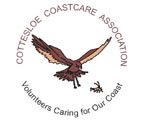Grande Finale!
We can all breathe a collective sigh of satisfied relief - this week the last of altogether 2,696 local seedlings for 2008 were planted by Cottesloe Coastcare members and their many helpers. All of these plants were propagated for us by APACE from seeds collected and cuttings taken by us from our local species - so they all belong here and will increase and sustain the growing biodiversity of Cottesloe's natural areas.
This year, we concentrated our efforts on nurturing and complementing our existing projects - as you have read in previous postings, we have worked with students from Cottesloe Primary School and Scotch College, with staff from Pricewaterhouse Coopers and Future Farm Industries, and volunteers from Conservation Volunteers Australia, sponsored by Woodside Industries. In addition to joining these groups for long hours of intensive weeding and planting, several Cottesloe Coastcare members worked individually on various sites in the dunes, at Mudurup Rocks and in the Cottesloe Native Gardens to ensure that gaps in the local vegetation will eventually be closed and introduced species removed.
Now we want lots of rain to enable all of our plants to grow and prosper!
[Photo by Sue Freeth]
This year, we concentrated our efforts on nurturing and complementing our existing projects - as you have read in previous postings, we have worked with students from Cottesloe Primary School and Scotch College, with staff from Pricewaterhouse Coopers and Future Farm Industries, and volunteers from Conservation Volunteers Australia, sponsored by Woodside Industries. In addition to joining these groups for long hours of intensive weeding and planting, several Cottesloe Coastcare members worked individually on various sites in the dunes, at Mudurup Rocks and in the Cottesloe Native Gardens to ensure that gaps in the local vegetation will eventually be closed and introduced species removed.
Now we want lots of rain to enable all of our plants to grow and prosper!
[Photo by Sue Freeth]


 Mike Ewing and his team from Future Farm Industries CRC took a morning out from their normal focus, researching new and adaptable farming systems, to get some hands on experience planting at Dutch Inn. Clearly a well-oiled team, they not only organised superb weather, but also fresh coffee to start the day!
Mike Ewing and his team from Future Farm Industries CRC took a morning out from their normal focus, researching new and adaptable farming systems, to get some hands on experience planting at Dutch Inn. Clearly a well-oiled team, they not only organised superb weather, but also fresh coffee to start the day!
